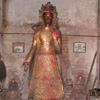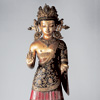On The Antiquity of Nepalese Metalcraft: The Buddha of Guita Bahi
- click on the image to enlarge | click on the image again to enlarge further
click Esc or X to close and return to this page
Figure 3: Śākyamuni Buddha, as Dīpaṅkara
The main deity of Prathama Śrī Mahāvihāra
(Prathamaśrī mahāvihārayā gandhurī devatā)
Cast Copper with traces of gilding, with gilt repousse copper covering.
h. approx 6 ft 8 in (Vajracarya, Herakaji, 1999, p 53)
Nepal, 542 CE (?)
Gilt repousse covering ca. 18th 19th c.
Shown with gilt repousse covering as Dīpaṅkara
Photo after Herakaji Vajracarya, 1999 before p. 1
Details: see thumbnails below
Detail 1, photo courtesy Gyanendra Shakya, showing the statue with the crown.
Detail 2 photo Sunil Dongol 8-3-2018. (NSS SD card)
Detail 3, Dīpaṅkara, Patan Museum, object 344, Nepal 17-18th c. Bronze, cast and repousse, gilt paint and semi-precious stones, H. 71 cm. Photo courtesy Thomas Schrom and Patan Museum
Citations; Published:
Slusser, Mary Shepherd, 1982, Nepal Mandala, two vols. (Princeton, New Jersey: Princeton University Press), vol. 2, plates 485, 486
Dīpaṅkara Buddha, copper repousse 13th c. (?)
Vajracarya, Herakaji, 1999 (N.S. 1119) Guitaḥyā Bahi Vihāra Sangh (Gustala Mahāvihāra, Prathamaśrī mahāvihāra, Vasuccaśīla Mahāvihāra chagu adyayana (A study of the Guita Bahi vihāra Sangha) (Dipavatī Putsakālaya, Guita, Patan), 2nd fig before p. 1, The main deity of Prathama Śrī Mahāvihāra (Prathamaśrī mahāvihārayā gandhurī devatā)
Michaels, Axel, 2013, "From Syncretism to Transculturality: The Dīpaṅkara Procession in the Kathmandu Valley" in Hüsken/Michaels, editors, South Asian Festivals on the Move, (Hüsken/Michaels,South Asian Festivals on the Move (Wiesbaden: Harrassowitz Verlag), pp 317-342. Fig. 2: The Guitah Dīpaṅkara Buddha at Guita Bahā, 13th cent. (photo: Manik Bajracharya, 2002)



